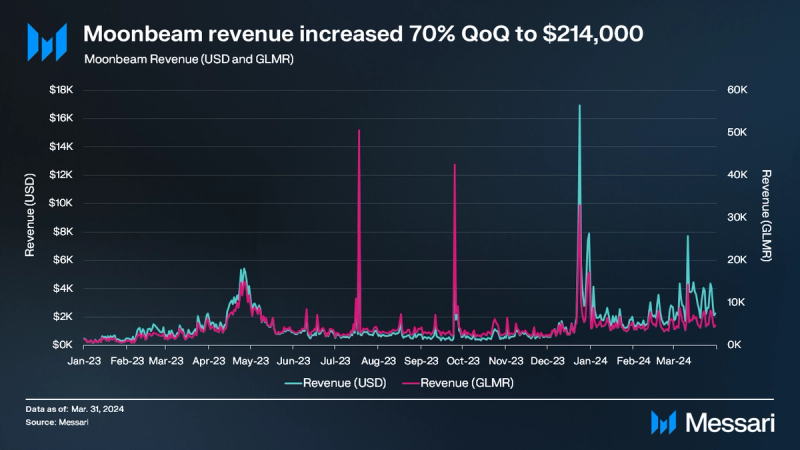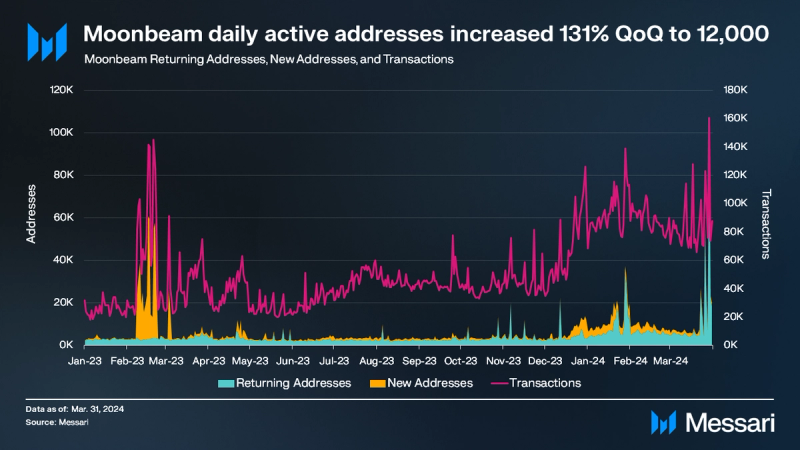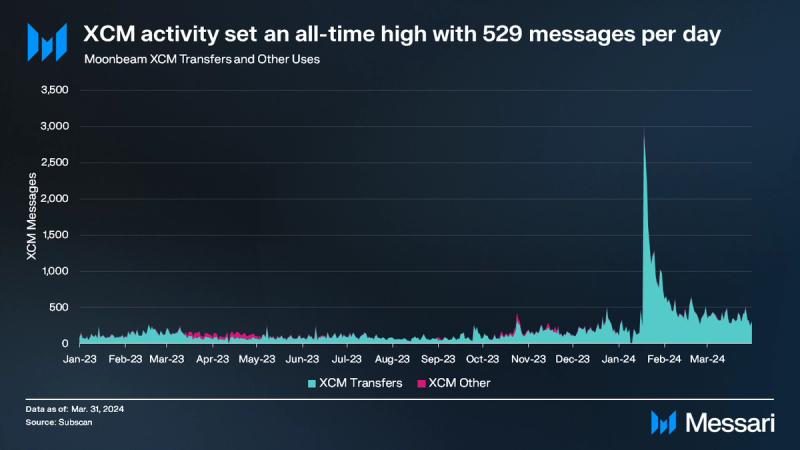Key Insights
- Network activity increased, with daily active addresses increasing by 131% to 11,800, and daily new addresses growing by 108% to 2,800. Moonbeam was the leading parachain by active addresses on Polkadot.
- Cross-Consensus Messaging (XCM) activity further increased and hit another all-time high with 529 messages per day (+186% QoQ). Manta launching their L2 and leveraging Moonbeam for asset transfers contributed to the spike.
- Announced XCM integrations with Composable, Pendulum, and Polkadex. Composable’s XCM integration with Moonbeam brings IBC assets from Cosmos and Kusama to the Moonbeam ecosystem, while the integration with Pendulum links the Polkadot ecosystem to the Stellar Blockchain.
- Moonbeam made several notable announcements in the gaming sector. These included a partnership with Animo Industries, the Lunar Gaming Festival April campaign, and the launch of Heroes Battle Arena.
Primer
Moonbeam (GLMR) is a Layer-1 parachain on the Polkadot Network, serving as an EVM-compatible smart contract platform. It provides an Ethereum Virtual Machine (EVM) implementation and a Web3 API, enabling straightforward deployment of Solidity contracts and protocol interfaces with minimal modifications. Its primary features include cross-chain integration, staking, and on-chain governance.
The network includes multiple deployments: Moonbeam on Polkadot (December 2021), Moonriver on Kusama (June 2021), and Moonbase Alpha on TestNet (September 2020). This structure ensures safe and rapid updates to Moonbeam’s mainnet.
Moonbeam’s technology stack, built with Rust and Substrate, provides a robust development environment. It boasts Ethereum compatibility, offering a full EVM implementation and Web3 RPC API, which integrates existing Ethereum tools and applications. As a key player in the Polkadot ecosystem, Moonbeam provides developers with an accessible route to leverage Polkadot’s network effects while utilizing Ethereum tooling and compatibility.
Website / X (Twitter) / Telegram
Key Metrics

Analysis

In Q1 2024, GLMR’s circulating market cap increased to $411 million (+11% QoQ), while the fully diluted market cap rose to $540 million (+7% QoQ). GLMR’s market cap ranking was approximately 225 among all networks. Within the Polkadot ecosystem, GLMR is the fourth largest parachain by market cap. For comparison, BTC increased 69% and ETH increased 53% QoQ.

Moonbeam reported revenue of 469,000 GLMR (+21% QoQ) driven by increased network activity. The revenue in USD saw larger gains of +70% QoQ to $214,000, further amplified by the increase in GLMR’s price.
GLMR is the native token of the Moonbeam network. It serves multiple functions, such as rewarding collators, enabling on-chain governance, and paying for network transaction fees. The token experiences an annual inflation of 5%, with no maximum supply. Of the transaction fees generated on the Moonbeam network, 80% are burned, with the remaining 20% directed to the network’s Treasury. After rising for several consecutive quarters, the percentage of GLMR staked remained flat at 36%.

Moonbeam’s network activity showed significant growth, with daily active addresses increasing by 131% to 11,800, daily new addresses growing by 108% to 2,800, and daily returning addresses rising by 139% to 9,000. Moonbeam is the leading parachain by active addresses. The developer community was also strong, with a total of 545 monthly active developers, including 173 full-time and 298 part-time contributors.
Another driver of the increased activity was Moonbeam’s expanding presence in Brazil. Through partnerships with entities like Brazilian Jiu-Jitsu organizations and financial institutions, Moonbeam has introduced solutions, like a Web3 loyalty program and asset tokenization, increasing transaction volumes and user engagement.
Additional key developments and community initiatives included:
- Runtime 2700: Introducing MBIP-5, deprecating Gov v1, and preparing for asynchronous backing.
- Moonbuilders Academy Course: Launched a course on cross-chain swaps & interoperability by Squid Router.
- Runtime 2801: Recalculating inflation using the relay slot as clock time, and modifying the round structure to be block-based with the number of blocks per round doubled.
- ETHDenver 2024 Hackathon: Hosted a Polkadot Mini-Summit session, BUIDLathon bounty for cross-chain dApp development, and networked with partners.
- Gauntlet Partnership: Aims to optimize Moonbeam’s grant programs, economic sustainability, and tokenomics.
- Moonbeam’s Tooling Ecosystem: A deep dive on Moonbeam’s developer tooling ecosystem showcasing available tooling.

Moonbeam’s Cross-Consensus Messaging (XCM) activity further increased and hit another all-time high with 529 messages per day (+186% QoQ), largely driven by asset transfers which comprise 98% of XCM activity today. The spike in XCM activity in late January was due to Manta launching their L2 and using Moonbeam to move assets between their Parachain and L2.
XCM developments included:
- Strategic Integrations: XCM integrations between Moonbeam and three parachains: Composable, Pendulum, and Polkadex. Composable’s XCM integration with Moonbeam brings IBC assets from Cosmos and Kusama to the Moonbeam ecosystem. The integration with Pendulum links the Polkadot ecosystem to the Stellar Blockchain.
- Runtime Enhancements: Runtime 2700 simplifies fee management for XCM transactions.
In Q3, Moonbeam introduced Moonbeam Routed Liquidity (MRL), facilitating over $10 million in total volume.

The Total Value Locked (TVL) in USD on Moonbeam was $59 million (-16% QoQ), and the TVL in GLMR was 122 million (-20% QoQ). Both TVL USD and TVL GLMR decreased, signaling an outflow of value from the network. All leading protocols saw a decrease in TVL except for StellaSwap, which increased to $11 million (+52% QoQ) driven by the stDOT boost campaign. Additionally, the Gauntlet partnership is aimed at increasing DeFi TVL and participation.
The leading protocols by TVL on Moonbeam are:
- Moonwell (Lending): 40 million (-18% QoQ)
- StellaSwap (Lending): 11 million (+52% QoQ)
- Prime Protocol (DEX): 4 million (-54% QoQ)
- BeamSwap (DEX): 2 million (-43% QoQ)
- FraxSwap (DEX): 2 million (-17% QoQ)
In the first quarter, notable DeFi developments included Moonwell announcing plans to allocate $2.3 million towards recovering bad debt resulting from a hack in its Frax Finance pools. Moonbeam released a blog focusing on the real-world assets sector, highlighting Transfero and Tokeniza, and another on the regenerative finance vertical, highlighting ReFi Hub emerging as the leading protocol. Additionally, the period was marked by the launch of Mean Finance and the execution of the $PINK airdrop, which distributed 50% of the $PINK supply to 12 projects.

Moonbeam’s stablecoin market cap slightly decreased to $7.3 million, but has been extremely stable the past year. Frax continues to dominate the ecosystem’s stablecoin market with a 72% share. Moonbeam’s stablecoin market ranking fell to outside the top 50. Despite the stagnation, Binance and Kucoin supported the Polkadot ecosystem by enabling native USDC and USDT deposits and withdrawals directly to the Polkadot AssetHub.
Additionally, Moonbeam made a notable push into the gaming sector in Q1 2024 with several key initiatives:
- A partnership with Animo Industries, the web3 game developer behind the third-person mech-shooter “Stars Arena.”
- Polkadot announced an active Games Bounty for solo game devs and studios, funded with 100,000 DOT.
- The Lunar Gaming Festival announced an April campaign, a community initiative run by Collators and Games in the Moonbeam & Moonriver ecosystem.
- Heroes Battle Arena, a multi-chain strategic battle game, launched on Moonbeam.
Closing Summary
In the first quarter of 2024, Moonbeam developed various aspects of its ecosystem. Network activity increased, highlighted by the rise in daily active and new addresses. The period also saw growth in the developer community, strategic integrations, and community initiatives. The 2024 strategic areas of focus for Moonbeam include cross-chain interoperability, gaming, real-world asset integration, and expansion into new regions. These areas aim to improve the ecosystem and connect with the broader crypto community.



















